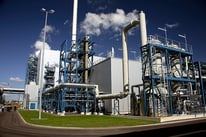 The Montreal Protocol on Substances that Deplete the Ozone Layer provides the international framework for protecting the earth’s stratospheric ozone layer, by identifying and minimizing emissions of ozone depleting substances (ODSs). The original Montreal Protocol was initialed in September 1987 (I summarized it here). It is widely considered an effective example of international cooperation (I blogged about the healing of the “ozone hole” here), in contrast with ongoing struggles to reach binding international agreements to address climate change. In fact, during 2016 efforts are underway to build on the Montreal Protocol’s strengths by amending it to address additional chemicals that may harm ozone and contribute to climate change.
The Montreal Protocol on Substances that Deplete the Ozone Layer provides the international framework for protecting the earth’s stratospheric ozone layer, by identifying and minimizing emissions of ozone depleting substances (ODSs). The original Montreal Protocol was initialed in September 1987 (I summarized it here). It is widely considered an effective example of international cooperation (I blogged about the healing of the “ozone hole” here), in contrast with ongoing struggles to reach binding international agreements to address climate change. In fact, during 2016 efforts are underway to build on the Montreal Protocol’s strengths by amending it to address additional chemicals that may harm ozone and contribute to climate change.
Adding Hydrofluorocarbons (HFCs) as “Ozone Depleting Substances (ODSs)”
The Montreal Protocol is designed to identify and then phase out production and use of ODSs. It presently divides identified substances into two broad classes, which generally can be thought of as high-depleting and less-depleting chemicals:
-
Class I substances (most depleting) consist of chlorofluorocarbons (CFCs) and halons; carbon tetrachloride; methyl chloroform; methyl bromide hydrobromofluorocarbons; and chlorobromomethane. They were phased out under schedules by 2005, although some “essential uses” (such as in medical devices) are still allowed.
-
Class II substances (less harmful) are hydrochlorofluorocarbons (HCFCs), which are being phased out on a percentage-of-baseline-production basis over time. This started with a 35% reduction in most HCFCc by 2003, has now reached 90% reduction, and is due to be entirely phased out by 2030.
They appear in five annexes to the protocol (Annex A through E).
Now, countries are proposing to add a list of 19 hydrofluorocarbons (HFCs), which would appear in a new Annex F and be subject to provisions yet to be negotiated. HFCs are used as less ozone-depleting alternatives to CFCs, but do contribute to ozone depletion. They also qualify as greenhouse gases (GHGs), and can be up to 10,000 times more potent than carbon dioxide in contributing to climate change.
What Phase-outs Are Being Proposed?
Negotiations on an HFC amendment (i.e., expansion) of the Montreal Protocol began during the November 2015 meeting of the parties in Dubai, establishing the “Dubai Pathway” to “work within the Montreal Protocol to an HFC amendment in 2016.” Various groups of countries have proposed HFC-related provisions, including:
-
The U.S., Canada and Mexico have proposed a phase-down from 2011-2013 baselines to 15% of those baselines by 2036 for developed countries and 2046 for others.
-
The European Union proposes a 2009-2012 baseline, and phasedown to 15% by 2034.
-
India proposes a 2013-2015 baseline, with phasedown to 15% by developed countries during 2016-2035, and by other countries during 2031-2050.
Impacts on climate change could be worth the effort. The United States estimates that acceptance of its proposal could avoid up to 0.5 degrees Celsius of warming by 2100.
What’s Next?
As the bare-bones summary above indicates, the various proposals include substantial differences as to timing, particularly between developed and other countries. Detailed comparisons identify many additional fine-grained distinctions that will have to be negotiated. However, the Montreal Protocol parties hope to complete a draft during October meetings in Kigali, Rwanda. If they succeed, the countries can begin to ratify the amendments which would enter into force once enough countries have ratified.
Implementation Checklist
Does the organization manufacture, import or use any ODS subject to the Montreal Protocol and/or CAA Title VI?
- If the phase-out date for any ODS has passed, does the activity qualify with applicable exceptions or essential uses?
Does the organization manufacture, import or use any HFCs?
Has the organization reviewed any such activity to begin to identify alternatives for any ODS or HFC that is or may become subject to phaseout?
Where Do I Go For More Information?
Information available via the Internet includes:
-
United Nations Environmental Program (UNEP) Ozone Secretariat
-
U.S. State Department webpage on the Dubai Pathway, with links to proposals and other documents
Specialty Technical Publishers (STP) provides a variety of single-law and multi-law services, intended to facilitate clients’ understanding of and compliance with requirements. These include:
About the Author
 Jon Elliott is President of Touchstone Environmental and has been a major contributor to STP’s product range for over 25 years. He was involved in developing 13 existing products, including Environmental Compliance: A Simplified National Guide and The Complete Guide to Environmental Law.
Jon Elliott is President of Touchstone Environmental and has been a major contributor to STP’s product range for over 25 years. He was involved in developing 13 existing products, including Environmental Compliance: A Simplified National Guide and The Complete Guide to Environmental Law.
Mr. Elliott has a diverse educational background. In addition to his Juris Doctor (University of California, Boalt Hall School of Law, 1981), he holds a Master of Public Policy (Goldman School of Public Policy [GSPP], UC Berkeley, 1980), and a Bachelor of Science in Mechanical Engineering (Princeton University, 1977).
Mr. Elliott is active in professional and community organizations. In addition, he is a past chairman of the Board of Directors of the GSPP Alumni Association, and past member of the Executive Committee of the State Bar of California's Environmental Law Section (including past chair of its Legislative Committee).
You may contact Mr. Elliott directly at: tei@ix.netcom.com.
